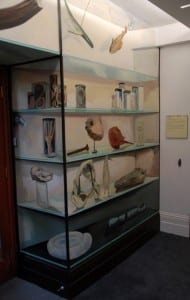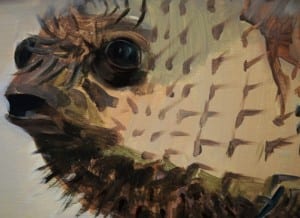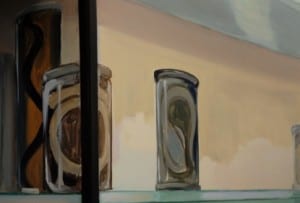Artist at the Grant Museum
By Sarah R Cameron, on 18 March 2013

Viewpoint – Sarah Cameron (2013)
I arrive at the Museum at a strangely early hour of the morning, with my over-flowing bag of art materials and an array of tools. I ensconce myself in the foyer, surrounding myself with tubes of paint, mediums, cloths, sandpaper and sandwiches and then set to work in the quiet time before the museum opens.
Much of my mural painting has been made in situ, which is a new and exciting way for me to work and through this I have found an energy in the way I handle paint that I have been striving for.
It has been a fantastic privilege to be allowed access to the museum outside it’s normal opening hours and to have a ‘behind the scenes’ insight into a world of scientific investigation and recording that has often been elusive to me. As a painter I find the way that artefacts are preserved, restored and displayed fascinating and that is what first inspired me to make the painting.
To make an artwork for the Grant Museum I wanted to think about what it is about the museum that I find so appealing – what it is about the artefacts and the spaces they occupy that give them the extraordinary and magical quality that set them apart from other displays of objects and specimens.

Pufferfish in Viewpoint – Sarah Cameron (2013)
The dialogue between the all-encompassing atmosphere of a place and the recognition of a single object relates directly to my own work. I have recently painted objects from collections such as the British Museum and Kew Gardens and through a process of selection, comparison and framing, depicted them in a way that has some objects clearly recognisable, while others need the reference point of their surroundings to be established as part of the collection. It is this area between clarity and obscurity and the relationship that this has to memory that I find intriguing.

Jars in Viewpoint – Sarah Cameron (2013)
I have had the fantastic experience of being welcomed into the museum and have been allowed free reign to meander through the collection, indulging my unorthodox selection processes, allowing the personalities of the objects to grasp my eye and my interest. I’ve been drawn to their texture, colour, shape, form and positioning, allowing my penchant for the esoteric to add another layer to their portrayals.
The unique visual personalities of the objects are integral to my piece. When I walk into the museum I can let my imagination run riot. It is an exploration of nature that is both familiar and peculiar, engaging with far away times and places, the depths of the ocean, the underground, life in the desert, as well as the everyday – moles, spiders, ants, to name but a few. In my piece I want to draw on the all-encompassing, enveloping aspect of the natural world while also suggesting the single viewpoint from which we make our judgements and comparisons of it.
The painting has been made so that from the angle and height of the artist’s eye, the solid wall looks like a three dimensional cabinet, enticing the viewer – in a quest to align and distort the illusion – to a position of questioning.
The shifting perspective is indicative of the individual nature of peoples’ experiences of the collection. This runs parallel to the Museum’s perceived role: the pursuit of taxonomic investigation. The collection is modified according to its viewer.
The painting was made without the use of digital aids, grids or formulae.
Sarah Cameron is studying for a Masters in Fine Art at the UCL Slade School of Fine Art. Her work “Viewpoint” was selected in a competition run by the Grant Museum, in a project generously funded by DCMS Wolfson Museums and Galleries Improvement Fund.
3 Responses to “Artist at the Grant Museum”
- 1
-
2
Ronald wrote on 25 May 2013:
We absolutely love your blog and find nearly all of your post’s to be precisely what I’m looking for.
Does one offer guest writers to write content in your case?
I wouldn’t mind producing a post or elaborating on a number of the subjects you write concerning here. Again, awesome blog! -
3
David Noble wrote on 15 November 2017:
While investigating the Grant Museum online I have come across your painting project. I must visit the museum and see it. It looks intriguing. I wanted to write and say how much I liked reading your blog. It is extremely well and honestly written. So often what contemporary artists write is incomprehensible to the uninitiated and hardly more helpful to the initiated. You articulate your interests and impressions and experiences very clearly and it is a pleasure to read them. Thank you.
 Close
Close


[…] of a skull or looking for the differences between fossils. Alternatively we could have an artist creating an installation for our Foyer and we’re excited to see the reactions to the museum for our upcoming sculpture season […]